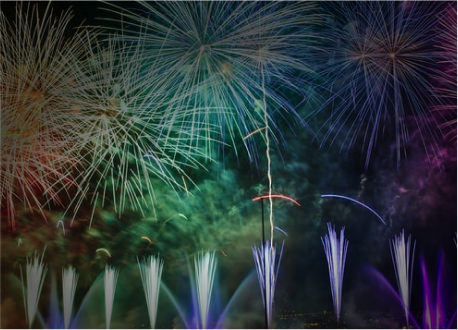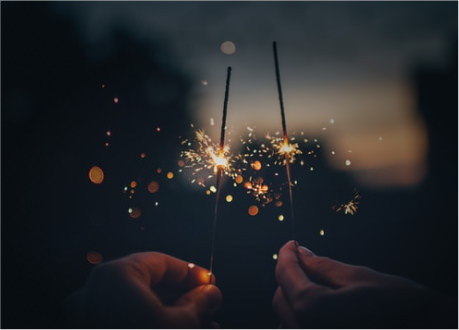How Fireworks Are Made

Lighting up a firework during an event is all about fun and festivities, no matter whether it’s a birthday, wedding, new year’s celebration, fourth of July, or something else. But have you ever wondered what makes this possible? No matter the type, fireworks are all about engineering the right chemicals in the right proportions so that the proper explosions are created. Before a firework can lighten up the sky, it must be meticulously and carefully crafted. The manufacturing process can take days to complete. Read on to learn how fireworks are made, what ingredients are used, and more.

Pyrotechnics – The Science of Making Fireworks
The word pyrotechnics is derived from two Greek words: “pyre”, which means fire, and “tekhnicos”, which means made by art. Pyrotechnics is the science of creating exothermic reactions to create sound, smoke, gas, light, or heat. It is used to create fireworks, parts of automotive airbags, oxygen candles, explosive bolts, gas pressure blasting in quarrying and mining, among other things.
Firework creation involves three primary components: fuel, oxidizer, and some special chemicals to produce the desired colours. Oxidizers are chemicals that are required to make fire. They are responsible for chemicals to lose electrons. Oxidizers use oxygen in the air to make fire. The most commonly used oxidizers are perchlorates, chlorates, and nitrates. The fuel’s job in a firework is to combine with the oxygen that oxidizers release, breaking the fuel’s chemical bonds. This releases the energy in those chemical bonds and results in an explosion. The most commonly used fuels in fireworks are sulphur or charcoal. All you need is a bit of fire to start the chain of chemical reactions.
The Body of a Firework
Different types of fireworks are made up of various components. Since the aerial firework is the most common and widely used type, the article explores its composition, how it’s made, and more. Following are the primary components of an aerial firework:
Break
Stars are kept in separate compartments made of cardboard in the shell of a firework. This is particularly the case with multi-break fireworks. Each compartment has its own bursting charge, which throws out the stars when it is ignited. The compartment must burst open with a great force so that the decorations are spread over a large area of sky. The heavy wrapping of the break creates resistance and temporarily keeps the heat and gas from reaching the bursting charge.
The breaks of the firework may also contain sound charges that result in the thunderous booms and cracking bangs that thrill audiences. To make these loud explosions, firework manufacturers use mixtures of perchlorate, which is different as compared to black powder.
Time-Delay Fuse
As the firework ascends in the sky, the time-delay fuse keeps on burning. When the firework is near its summit, the fuse has burned enough to ignite the black powder confined in the first break or compartment. Timing is critical here. In a multi-compartment firework, the middle compartment or break needs to ignite at the highest point in the shell’s trajectory. Therefore, the first break should blow a little before and the third break a little after. Firework manufacturers pay great attention and care when designing the time-delay fuses to ensure that the firework does not detonate too close to the ground.
Stars
Stars are the valuable cargo that aerial fireworks carry. An unlit star is nothing spectacular – it is a tiny, dull black lump. But looks can be deceiving. When ignited, stars create impressive flashes of light and colour.
Fireworks manufacturers craft hundreds of stars by hand, each of which is used in a single firework. Manufacturers mix carefully measured ingredients like black powder and perchlorate with colouring and binding agents: aluminium or magnesium for white, copper salts for blue, barium nitrate for green, strontium nitrate for red, sodium salts for yellow, and charcoal or other types of carbon for orange. The resulting material is a massive slab of dough that is then cut into half-inch cubes and set out to dry.
Black Powder
The recipe for gunpowder, or black powder, the primary material in all fireworks, has remained essentially the same since it was first discovered about 2,000 years ago in China: 10% sulphur, 15% charcoal, and 75% potassium nitrate. Black powder is a “low explosive” and lends itself to fireworks. Firework manufacturers use several different ways to control the powder’s rate of burn.
Launch Tube
Most fireworks are launched from steel or fiberglass tube rows seated in wooded racks that are secured in troughs of sand or wooden steaks . The mortars or tubes generally have the same diameter, but they are three times longer than firework shells.
Main Fuse
In ancient times, pyrotechnicians used to ignite their fireworks with tissue paper that was rolled around a black powder trail. Later, string featuring gunpowder was used. Nowadays, electrical wires connect a master control board to the fireworks. With a push of a button, the electrical current rushes through the wire, creating a spark that ignites the main fuse. The main fuse ignites the two secondary fuses at the same time. One is the time-delay fuse that is buried inside the shell that leads to the heart of the firework, and the other is a side fuse that acts fast to ignite the lift charge.
Lift Charge
When black powder burns in the open air, the gas and heat it generates quickly dissipate. But if the black powder is confined, e.g. in a pouch at the firework cylinder’s bottom, the trapped gas and heat will push vigorously at the inside of the launch tube until an explosion occurs. This explosion frees the gas and heat and hurtles the firework shell high into the air.
When we think of fireworks, things like incredible bursts of colour and light that paint the night sky usually come to mind. But these bursts are only the magnificent end of fireworks that likely took years of experience, hours of labour, and weeks of planning to fashion and fire. Creating a firework is an art in its own right.







